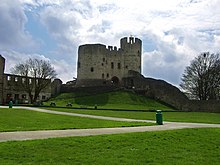Castles of England/West Midlands
There is one castle of note in the West Midlands.
| Name |
Type |
Date |
Condition |
Ownership / Access |
Notes (Key) |
|---|---|---|---|---|---|
| Dudley Castle | Keep and bailey | 13–14th century | Ruins | Dudley Zoo |
Slighted in 1647, then rebuilt and inhabited until destroyed by fire in 1750, partly restored 19th century. |

Dudley Castle is a ruined castle in the town of Dudley. The castle stands on an outcrop of Wenlock Group limestone. Local legend states that a wooden castle was constructed on the site in the 8th century by a Saxon lord called Dud or Dado. However this legend is not taken seriously by historians, who usually date the castle from soon after the Norman Conquest of 1066. It is thought one of the Conqueror's followers, Ansculf de Picquigny, built the first castle in 1070 and that his son, William Fitz-Ansculf, was in possession of the castle when it was recorded at the time of the Domesday Book of 1086. Some of the earthworks from this castle, notably the 'motte', the vast mound on which the present castle keep now sits, still remain.
After Fitz-Ansculf, the castle came into the possession of the Paganel family, who built the first stone castle on the site. This castle was strong enough to withstand a siege in 1153 by the forces of King Stephen. However, after Gervase Paganel joined a failed rebellion against King Henry II in 1173 the castle was demolished by order of the king. The Somery's were the next dynasty to own the site and set about building the castle in stone starting in the second half of the 13th century and continuing on into the 14th. The keep (the most obvious part of the castle when viewed from the town) and the main gate dates from this re-building. A chapel and great hall were also constructed.
Starting around 1540, a range of new buildings were erected within the older castle walls. The architect was William Sharington and the buildings are thus usually referred to as Sharrington Range.
The castle became a Royalist stronghold during the English Civil War, and was besieged twice before its surrender to Cromwell's forces in 1646. The first siege in 1644 was lifted after the Royalists sent a relief force which drove away the Parliamentarians. In 1646 Sir William Brereton commanded the Parliamentarians in the second siege against the Royalists led by Colonel Leveson. The castle was surrendered on 13th May 1646. Parliament subsequently ordered that the castle be partly demolished and the present ruined appearance of the keep result from this decision.
A stable block was constructed on the site at some point before 1700. This was the final building to be constructed in the castle. The bulk of the remaining habitable parts of the castle was destroyed by fire in 1750.
